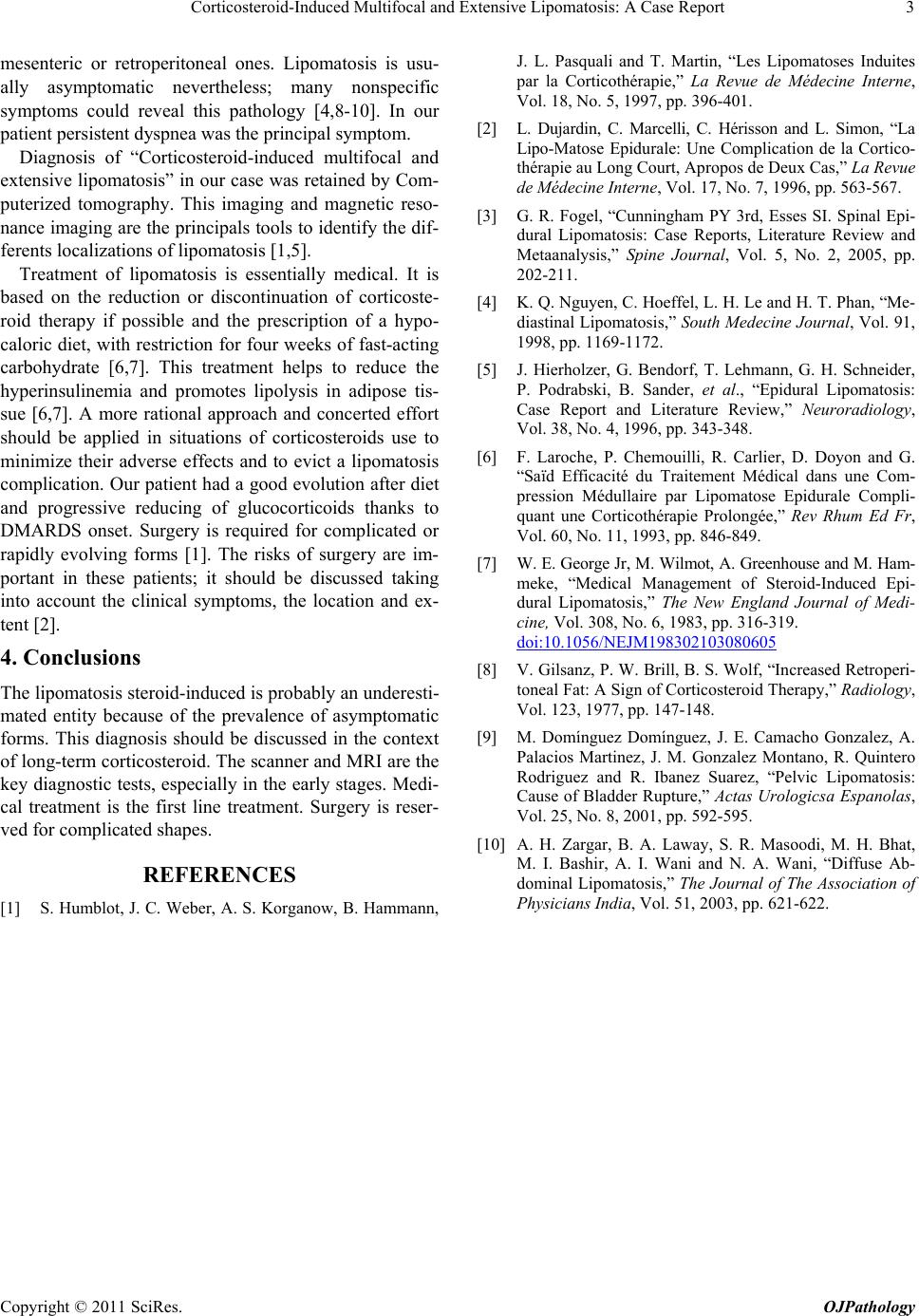
Corticosteroid-Induced Multifocal and Extensive Lipomatosis: A Case Report 3
mesenteric or retroperitoneal ones. Lipomatosis is usu-
ally asymptomatic nevertheless; many nonspecific
symptoms could reveal this pathology [4,8-10]. In our
patient persistent dyspnea was the principal symptom.
Diagnosis of “Corticosteroid-induced multifocal and
extensive lipomatosis” in our case was retained by Com-
puterized tomography. This imaging and magnetic reso-
nance imaging are the principals tools to identify the dif-
ferents localizations of lipomatosis [1,5].
Treatment of lipomatosis is essentially medical. It is
based on the reduction or discontinuation of corticoste-
roid therapy if possible and the prescription of a hypo-
caloric diet, with restriction for four weeks of fast-acting
carbohydrate [6,7]. This treatment helps to reduce the
hyperinsulinemia and promotes lipolysis in adipose tis-
sue [6,7]. A more rational approach and concerted effort
should be applied in situations of corticosteroids use to
minimize their adverse effects and to evict a lipomatosis
complication. Our patient had a good evolution after diet
and progressive reducing of glucocorticoids thanks to
DMARDS onset. Surgery is required for complicated or
rapidly evolving forms [1]. The risks of surgery are im-
portant in these patients; it should be discussed taking
into account the clinical symptoms, the location and ex-
tent [2].
4. Conclusions
The lipomatosis steroid-induced is probably an underesti-
mated entity because of the prevalence of asymptomatic
forms. This diagnosis should be discussed in the context
of long-term corticosteroid. The scanner and MRI are the
key diagnostic tests, esp ecially in the early stages. Medi-
cal treatment is the first line treatment. Surgery is reser-
ved for complicated shapes.
REFERENCES
[1] S. Humblot, J. C. Weber, A. S. Korganow, B. Hammann,
J. L. Pasquali and T. Martin, “Les Lipomatoses Induites
par la Corticothérapie,” La Revue de Médecine Interne,
Vol. 18, No. 5, 1997, pp. 396-401.
[2] L. Dujardin, C. Marcelli, C. Hérisson and L. Simon, “La
Lipo-Matose Epidurale: Une Complication de la Cortico-
thérapie au Long Court, Apropos de Deux Cas,” La Revue
de Médecine Interne, Vol. 17, No. 7, 1996, pp. 563-567.
[3] G. R. Fogel, “Cunningham PY 3rd, Esses SI. Spinal Epi-
dural Lipomatosis: Case Reports, Literature Review and
Metaanalysis,” Spine Journal, Vol. 5, No. 2, 2005, pp.
202-211.
[4] K. Q. Nguyen, C. Hoeffel, L. H. Le and H. T. Phan, “Me-
diastinal Lipomatosis,” South Medecine Journal, Vol. 91,
1998, pp. 1169-1172.
[5] J. Hierholzer, G. Bendorf, T. Lehmann, G. H. Schneider,
P. Podrabski, B. Sander, et al., “Epidural Lipomatosis:
Case Report and Literature Review,” Neuroradiology,
Vol. 38, No. 4, 1996, pp. 343-348.
[6] F. Laroche, P. Chemouilli, R. Carlier, D. Doyon and G.
“Saïd Efficacité du Traitement Médical dans une Com-
pression Médullaire par Lipomatose Epidurale Compli-
quant une Corticothérapie Prolongée,” Rev Rhum Ed Fr,
Vol. 60, No. 11, 1993, pp. 846-849.
[7] W. E. George Jr, M. Wilmot, A. Greenhouse and M. Ham-
meke, “Medical Management of Steroid-Induced Epi-
dural Lipomatosis,” The New England Journal of Medi-
cine, Vol. 308, No. 6, 1983, pp. 316-319.
doi:10.1056/NEJM198302103080605
[8] V. Gilsanz, P. W. Brill, B. S. Wolf, “Increased Retroperi-
toneal Fat: A Sign of Corticosteroid Therapy,” Radiology,
Vol. 123, 1977, pp. 147-148.
[9] M. Domínguez Domínguez, J. E. Camacho Gonzalez, A.
Palacios Martinez, J. M. Gonzalez Montano, R. Quintero
Rodriguez and R. Ibanez Suarez, “Pelvic Lipomatosis:
Cause of Bladder Rupture,” Actas Urologicsa Espanolas,
Vol. 25, No. 8, 2001, pp. 592-595.
[10] A. H. Zargar, B. A. Laway, S. R. Masoodi, M. H. Bhat,
M. I. Bashir, A. I. Wani and N. A. Wani, “Diffuse Ab-
dominal Lipomatosis,” The Journal of The Association of
Physicians India, Vol. 51, 2003, pp. 621-622.
Copyright © 2011 SciRes. OJPathology